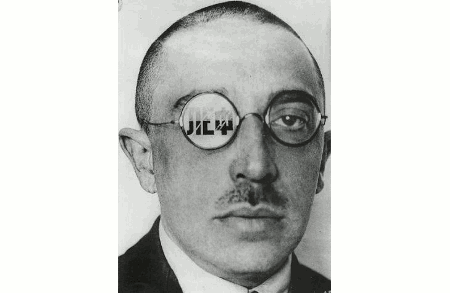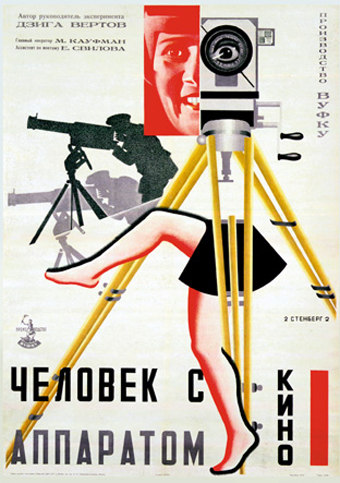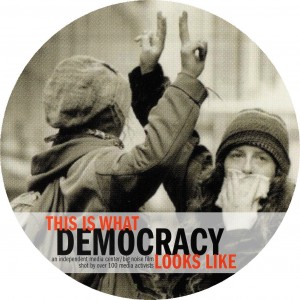11 2009
Into Information!
Reversing History for the Present
Osip Brik with logo of the journal Lef, photomontage by Aleksandr Rodchenko (1924)
Makrolab on Campalto Island (2003)
As Dimitry Vilensky explained, the experimental process of the Chto Delat group only advances by “permanently risking a shared madness.” I offer the following in exactly that spirit.
Like the Soviet productivists, we are faced today with immense changes in both the technological system and in the social relations whereby it functions. Since 1989 the capitalist labor force has doubled, due to the introduction of the former communist countries into the international trading system and to massive shifts of rural peasantries to market economics or indeed, to a worker’s life in the city. Whatever name you care to give it – globalization, informationalism, flexible accumulation – this new deployment of capitalism represents a metamorphosis no less sweeping than the advent of assembly-line manufacturing in the early decades of the twentieth century. As I summed it up a few years ago: “Geographical dispersal and global coordination of manufacturing, just-in-time production and containerized delivery systems, a generalized acceleration of consumption cycles and a flight of over-accumulated capital into the lightning-fast financial sphere, whose movements are at once reflected and stimulated by the equally swift evolution of global media: these are among the major features of the flexible accumulation regime as it has developed since the late 1970s.” The new productive regime opens up vast possibilities of intervention to any artist who tries to engage with it – and many have done so. Any look back at the productivists from our position today remains incomplete without drawing explicit parallels to the activities of artists in the tumultuous period of transformation that has unfolded in living memory, and is still unfolding.
These changes in the mode of production could not have occurred without the massification of access to the Internet and to the many technological systems that have converged over the last two decades, via the global hardware networks of cables, servers and routers and the TCP/IP transmission standard that functions as the general equivalent of information. The existence of a new distribution system fundamentally altered the status, potential and responsibility of the artist, or at least, of those artists who were most aware of and most sensitive to the shifts in social relations. The ardently desired opportunity to hook a whole range of publishing platforms and lightweight audiovisual recording devices into the worldwide distribution system gave rise to vital needs for the disalienated appropriation and redeployment of what had originally been a technology of command and control. The networked communications devices emerging from the military and corporate labs had to be grasped in their materiality and in their logical and semiotic structures, in order to reshape their potentials and reorient their uses. This meant leaving the studio, the gallery, the museum and the academy, to take up the tools of the engineer and to explore the infrastructures of globalized industry. After a careful, yet also audacious look back at the Soviet productivists of the 1920s, the agenda of the leftist vanguards in the 1990s becomes clear. It can be summed up in two words: “Into information!”
Specialists in the field will undoubtedly gasp at my adaptation of Osip Brik’s famous slogan, “Into production!” The reasons why are evident: first constructivism, then productivism were ostensibly founded on the rejection of language, syntax, representation, reflection and interpretation, as well as the compositional techniques that they imply in art and all the visual adaptations of literary simile, metaphor, allegory, allusion, etc. In other words, from a strict historical viewpoint the linguistic vagaries of information could only be the opposite of the material functionality sought by the productivists. Yet this did not stop Marko Peljhan from cloaking his reinvention of the artist’s laboratory in an explicitly constructivist and productivist guise, which is the sculptural form and the operational agenda of the Makrolab, with its extensive capacities for grappling directly with the military and corporate technologies of information. The proposal of a “new productivism” in contemporary art clearly owes much to this example, as it also does to the equally explicit gesture of the Activist Club constructed by Chto Delat. These are strong proposals, where the historical reference is not merely decorative, but generative. As art critics, can we not glimpse the unfulfilled potentials of the past in the most audacious inventions of the present?
However, I do not want to appeal only to the audacity of artists in this attempt to describe a new productivism. The contributions of the art historians Devin Fore and Christina Kiaer challenge the initial self-interpretation of the constructivist artists during their “laboratory phase,” revealing some of the paradoxes that the Soviet artists faced when they went into production. The results of these fertile inquiries show that the difficulties faced by what might be called the “informationalist” artists of the 1990s and 2000s, as well as the attempts to resolve those difficulties, are not without parallels to the conditions that the productivists faced during their entry into the realm of mass manufacturing and the machine process. Let us look more closely at these parallels.
Poster, Dziga Vertov, Man with a Movie Camera (1929)
On the one hand, the issue of appropriation is paramount in both cases: for resistant leftist artists confronted with an emerging industrial system, it is a matter of finding languages to make the reified products of distant laborers appear as the fully sensible, comprehensible and sharable tools of a collectively productive activity. This is the role of the “operative word” whose theory Devin Fore uncovers in the work of Alexei Gastev, which anticipates many of the concerns of cybernetics.1 It is also the role of filmic montage for Vertov, in Man with a Move Camera (1929) or in the sound film Enthusiasm: A Symphony of the Donbass (1931), portraying Ukranian coal miners. The corollary of Vertovian montage in the informational economy is clearly hypertext in the revolutionary and disalienated perspective opened up by Ted Nelson in his early book Computer Lib/Dream Machines (1974). Nelson launched one of the major strategies of resistance to the control society, by seizing and appropriating the information-processsing device at its very core: the code. And let no one object that the Soviet artists who reached the factory floor did not have to be resistant: for it would be naive to think that the imposition of Taylorist-type management techniques in the revolutionary factories was any less alienating in the late 1920s and mid-30s than the continual flux of cybernetic control messages has been from the 1990s to today. Only when Soviet productivism is conceived in its resistant, vanguard role does it begin to take on meaning for our time.
On the other hand, it is a matter in both cases of entering into the subtle and intimate struggle over the production of subjectivity at the affective and partially unconscious levels of sexuated existence and re-production, as mediated by the clothing, fashion, domestic tools and commodities that Popova, Stepanova and Rodchenko attempted to design and put into production, as we see in Christina Kiaer’s pathbreaking texts.2 Grasping the relation between industrial production and affective experience in the Soviet era makes it particularly relevant to our own time, where the “mediatization of consciousness” through electronic devices and the symbolic contents they help circulate has become the mainstay of the economy. The feminist front of informationalist art, opened up discursively by Donna Harraway in her famous portrait of the cyborg, came to exercise a major influence on all levels from the mid-1990s onward, through carefully constructed circuits such as the ironically named Old Boys Network. The histories of net.art and net.criticism in the 1990s, as well as the continuing development of an immanent critique of the Internet by circuits such as Nettime, provide many examples of the parallels between the productivists and the informationalists – that is, for anyone who can throw off their attachment to the authority of the past and overcome the general unwillingness to take a stand in the present disaster, the way the Soviet artists did.
That said, it would be a mistake to over-stress the similarities. A gaping chasm obviously separates leftist artists in nascent proto-socialist societies from new-leftist artists in dying hyper-capitalist societies. In addition to that caveat, I see two almost perfect inversions between the figures of the productivist and the informationalist artist. Indeed, this inverse symmetry is so strong that it reinforces the possibility of comparison even while destroying any misleading point-by-point analogy. The reason for this is that the precisely opposite positions of the two types of artists result from the dialectical negations that each new mode of production (or if you prefer, of industrial praxis) imposes on the previous one. Thus the artistic responses to the two modes of production – the factory and the network, the machine process and informationalism, or if you prefer, Fordism and post-Fordism – appear in their symmetrical differences, displaying the formally inverted structure of a chaismus. Let us consider the double dialectical reversal that produces this chiasmus.
First of all, in the text delivered at the MacBa conference – under the title “Arbeit sans phrase” – Devin Fore reflects on the condition of industrialized man subjected to the drudgery of the Fordist assembly line, quoting Hannah Arendt to evoke the danger of a mute subservience that left humanity “on the verge of developing into an animal species.” He sees Vertov’s filmmaking as a response to this underlying menace. But the post-Fordist cybernetic communication regime, whose rise has precisely to do with the attempt in the capitalist countries to overcome the alienation of the machine process to which the downfall of communism is often attributed, confronts us with exactly the opposite threat. Humanity is now in danger of becoming all talk, with no body, no time, no territory. The recent realization, as a really existing social-technical device, of Paul Klee’s quizzical pictorial utopia The Twittering Machine (1922) clearly confirms the point. What is missing today is not language but the mutism of resistance, the “I would prefer not to” of Bartelby the Scrivener – or what I have elsewhere called “the pathic core at the heart of cybernetics.” Doug Ashford’s text, which recounts his rediscovered concern with the pictorial sovereignty of abstraction following upon a dismaying experience with the pseudo-politics of contemporary linguistic chatter, fits directly into this new predicament. The ultimate meaninglessness of the informational flux is the distractive background against which an art of percepts and affects – or what Guattari would have called an a-signifying semiotics – takes on a new resonance, far from the machine process that confronted the productivists.
The second inversion between the situation of productivist and informationalist artists becomes apparent when one reconsiders Benjamin Buchloh’s assessment of factography. He claims that the visual factographers sought systems of representation-production-distribution that could recognize collective participation by establishing the conditions of “simultaneous collective reception” in a vast territory that was spatially fragmented by the industrial division of labor.3 Yet the historical realization of this quest, in Buchloh’s analysis, was the oppressive propaganda machine of the fascist and totalitarian dictatorships, whose lingering effects can still be felt in the contemporary mass media (Fox News, etc). Today, however, the informationalist artist does not only face the visual and discursive hangovers of the former mass-mediated societies, but above all, a situation where the disjointed assembly lines of globally coordinated just-in-time production are reflected at light-speed (literally: via fiber-optic cable) in the disjointed, desynchronized, hyper-individualized reception of networked media, whose extreme tendency is that of automatically generating pseudo-messages tailored to the profiles of single receivers. The difficulty for leftist thinking is inescapable here, because as Hito Steyerl insists in her critical work as well as her films, we cannot possibly desire any return to simultaneous collective reception. The reason is that differentially articulated reception represents a victory – or at least, a partial victory – over the oppressive nature of fascist broadcasting and contemporary capitalist mass media. What we need therefore, in my view, is to produce is the possibility of a simultaneous collective response to the fragmented conditions of differentiated reception. This, and perhaps this alone, can lend political agency to informationalist art production.
Big Noise Films and Indymedia (2000)
Shot by over 100 media activists
So far, the most clearly self-aware attempt to insert an alternative operational process into the new system of communication and control is the one carried out by the meeting of open-source software engineers and agit-prop tactical media artists collaborating within the broad spectrum of social and political forces that was known as the counter-globalization movement, and that is now being re-articulated within the context of the twin struggles against precarity and climate change. In these movements, people from vastly different horizons, animated by their own singular concerns, succeed in converging at particular times, in particular places, around particular sets of issues that have been carefully framed so as to leave their evolution open to the new existential situations that continually arise amid the rapidly circulating flow of affects and images and signs. What is striking in these contexts is the relation of the informational flux and knowledgeable bodies in the street, as well as the social relation, most apparent in the Latin American region, between post-Fordist language workers and indigenous peoples – a relation which has gained extraordinary salience in the World Social Forums as well as in the electoral victories of Chávez and Morales. Similar encounters also occur without the ostensible presence of engineers and technicians. One example, plucked from among hundreds, would be the remarkably virulent work of Mujeres Creando with all kinds of marginal social actors in Bolivia. In a different vein, one could recall the urban tactics of Doina Petrescu and Constantin Petcou with local inhabitants and vernacular architecture in Paris, or Precarias a la Deriva in Spain, and so forth.
These aestheticized relations between language workers and marginal social subjects appear at first glance paradoxical, as they disturb the purity of an analysis based on successive modes of production, fetishizing first the assembly line, then the computer. What is at stake, however, is precisely a resistant critique of the dominant relations of production, a critique which includes both the appropriation of useful tools and the rupture with mystifying ideologies. Just as the productivists needed to go to the factory floor to complete the critique of the bourgeois idealism from which their artistic practice was gradually emerging, so the informationalist artist must sink all the way into the biological substrate of every information system – and therefore, into the human nervous system in its cellular and sexuated chaos, far from its schematic cybernetic caricature. What is called biopolitics is exactly this movement of submersion/subversion: learning to inhabit and fully embody the circulation of mathematicized information that currently alienates our linguistic capacities and estranges us from political agency. Such a bodily engagement risks at once the speed of information through fiber-optic cables and the resistance of flesh, bone and memory, discovering a living solidarity where capitalism can only see – and manage – the abstract circulation of meaningless deadly bits. At the outset of the 1990s and perhaps even more so today, the great artistic challenge remains the plunge into information, that is to say, into the unfolding of the present as the lived experience of social relations that can be changed.
The tracing of a chiasmatic parallel between productivist and informationalist artists is exactly the kind of contribution that art history could make to aesthetic and political practice in the present, if it dared; and that contemporary art criticism could make, if it had the conceptual tools and the historical sophistication to do so. These are the pressing reasons for collectivism in the interpretation of art, and not only in its creation. To sketch out such a parallel as I have done above is not to fully realize its full potential, not by any means. For that we would need more time, deeper work, and above all, more acute and emancipated desire. But in these few short remarks formulated at the close of an extraordinarily interesting seminar, and at a time when the ultra-differentiated and mathematicized flux of financial capital appears to be reducing any form of resistance and political agency to a condition of fragmented and hyper-individualized insignificance, what I do hope to have done is something rather simple and yet essential. I hope to have reiterated, with the gains and insights of the experience itself, the demand that was implicit in the very proposal of a seminar on “the new productivisms”: the demand to face the conditions of the present, and to reach the core level at which they might ultimately be transformed.
http://brianholmes.wordpress.com/2009/11/22/into-information/
---
1 Devin Fore, “The Operative Word in Soviet Factography,” October 118, special issue on Soviet factography, Winter 2006.
2 Christina Kiaer, Imagine No Possessions: The Socialist Objects of Russian Constructivism (Cambridge, Mass.: MIT Press, 2005).
3 Benjamin Buchloh, “From Faktura to Factography,” October 30, 1984, available here.




